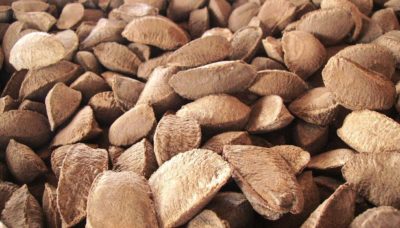
Brazil nut fruits - Photo by CIFOR
The Brazil nut is a large tree, which can reach 50 m tall. The trunk can be 1 to 2 m in diameter. It is one of the largest species of trees in the Amazonian rainforest.
Most Brazil nuts are harvested from naturally occurring trees. In some areas they are grown in plantations.
Names
Scientific
Bertholletia excelsa
English
Brazil nut
Dutch
Paranoot
Spanish
Castaña de monte
Nuez amazónica
Nuez de Brasil
French
Noix bresilienne
Noix d’Amazonie
Noix du Brésil
German
Amazonenmandel
Paranuss
Paranussbaum
Italian
Noce amazzonica
Noce del Brasile
Taxonomy
Genus
Bertholletia
Family
Lecythidaceae
Order
Ericales
Basic information and facts
Origin:
Brazil, Amazon area.
Distribution:
Brazil nuts are found in the Amazonian rainforest, but there are also some plantations in the Amazon area.
Deciduous or evergreen:
Brazil nut is a tropical evergreen tree.
Fruits:
The fruit is a large capsule with a diameter of 10 to 15 cm. The hard woody shell is 8 to 12 mm thick. The fruit contains eight to 24 triangular seeds, which are 4 to 5 cm long; these are called the “Brazil nuts”.
Climate and weather:
Tropical rainforest climate.
Pollination:
Flowers are pollinated by a large species of bee. In plantations it is sometimes difficult to attract the right species of pollinators.
Height:
Trees are 25 to 50 meters tall.
Propagation:
Propagated by seed.
Harvesting:
After pollination, the fruits takes 14-15 months to reach maturity. They are harvested by collecting them when they fall from the tree. The fruits are hard and must be opened with a machete to collect the nuts.
Uses:
Brazil nuts are eaten fresh or may be used to extract oil. The oil is used for cooking or for making soaps.
Crop categories
Nuts
Edible seeds
Tropical crops
Pictures

Brazil nut fruits - Photo by CIFOR

Brazil nut tree

Brazil nuts - Photo by Jean Marconi

Brazil nuts - ready to eat
